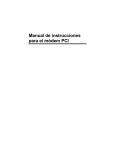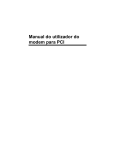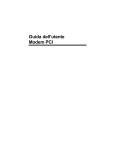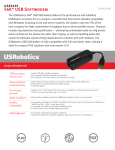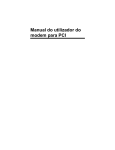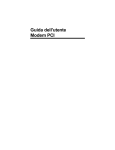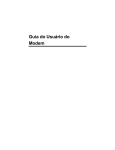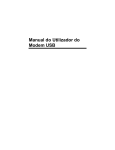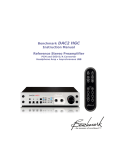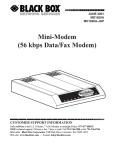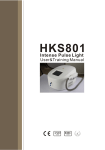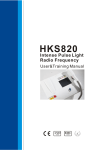Download The PCMCIA High Speed FaxModem Owner
Transcript
PCI Modem User Guide NOTICE This document contains proprietary information protected by copyright, and this User’s Manual and all the accompanying hardware, software, and documentation are copyrighted. All rights are reserved. No part of this document may be photocopied or reproduced by mechanical, electronic, or other means in any form. The manufacturer does not warrant that the hardware will work properly in all environments and applications, and makes no warranty and representation, either implied or expressed, with respect to the quality, performance, merchantability, or fitness for a particular purpose of the software or documentation. The manufacturer reserves the right to make changes to the hardware and User’s Manual content without obligation to notify any person or organization of the revision or change. All brand and product names are the trademarks of their respective owners. © Copyright 2001. All rights reserved. Contents INTRODUCTION .................................................................... 4 WHAT YOU NEED TO USE YOUR FAXMODEM................................ 4 INSTALLING YOUR PCI FAXMODEM.................................. 5 WINDOWS 95/98/ME/2000.......................................................... 5 WINDOWS NT 4.0....................................................................... 5 INSTALLING THE DRIVERS ........................................................... 5 INSTALLING THE FAXMODEM CARD .............................................. 7 COMPLETING THE INSTALLATION ................................................. 9 IMPORTANT INFORMATION FOR OWNERS OF V.92 MODEMS .............................................................................. 11 FIRMWARE UPGRADES .............................................................. 12 COMMUNICATING WITH YOUR FAXMODEM .................. 13 ACCESSING THE INTERNET ........................................................ 13 COMMUNICATION SETUP OPTIONS ............................................. 13 INITIALIZATION STRINGS AND AT COMMANDS............................. 14 TROUBLESHOOTING ......................................................... 16 PLUG AND PLAY SETUP PROBLEMS WITH WINDOWS .................. 16 OTHER TROUBLESHOOTING TIPS............................................... 19 APPENDIX A: HOW TO UNINSTALL MODEM DRIVERS .............................................................................. 29 APPENDIX B. REGULATORY INFORMATION.................. 31 APPENDIX C: REFERENCE INFORMATION .................... 35 Introduction This Modem User Guide expands the Quick Start included with your faxmodem package and contains all the information you should need to use and troubleshoot your new modem. The Table of Contents shows the various useful sections of this User Guide. What You Need to Use Your Faxmodem Make sure that you have received the following items in addition to this manual: • PCI faxmodem • Phone cord • A CD-ROM disc or floppy diskette containing installation software, modem drivers, and communications software. You also need the following: • Computer with 16 megabytes of RAM (32 MB recommended) and a hard drive with at least 5 MB available • An available PCI slot • For software supplied on a CD-ROM disc, a CD drive • Windows® 95, 98, Me, 2000, or NT 4.0 operating system • A telephone jack to plug the modem into, so the modem can dial out and receive calls • Screwdriver or tool to remove and replace your computer cover. 4 PCI Modem Installation Guide Installing Your PCI Faxmodem Windows 95/98/Me/2000 We have streamlined the installation of your modem by providing an InstallShield® program that you must run before you install your faxmodem card. The InstallShield program installs driver files and sets up your computer to recognize the new modem. When you restart your computer after installing the modem, your hard drive will already contain the files Windows needs to complete the installation. Please continue with the Installing the Drivers section, page 5. Windows NT 4.0 We have streamlined modem installation for Windows NT 4.0 computers, but the installation sequence is the opposite of other Windows operating systems. First you must install your new faxmodem card in your computer, then run the InstallShield® program. To begin, please go to the Installing the Faxmodem Card section on page 7. Installing the Drivers 1 Your computer should be turned on. Close any applications you have running. Insert the CD-ROM disc that came with your faxmodem into your CD-ROM drive. The CD-ROM disc should automatically start up in a few seconds and display an installation screen. If the CD does not start automatically: Installing your PCI Faxmodem 5 2 • Click the My Computer icon on your desktop; then double-click the icon for your CD-ROM drive. • If the installation program doesn’t start up immediately, double-click launch.exe. When the installation interface appears, click the Install Drivers button and then the PCI Drivers button. For Windows NT, you will also see the following dialog box. Make sure that the Install new modem driver and components option button is selected and click Next. The installation program will run and automatically copy driver files to your hard drive. Click Finish if you are prompted to do so. 3 Windows 95/98/Me/2000 Users: Follow the instructions for Installing the Faxmodem Card on page 7. Windows NT 4.0 Users: Please go to Completing the Installation on page 9. 6 PCI Modem Installation Guide Installing the Faxmodem Card Follow the steps below to install your faxmodem card. Note: If your computer has an existing modem, we recommend that you first uninstall the modem drivers. Please refer to Appendix A on page 29. 1 Before you start the hardware installation, close all running programs and shut down Windows if you have not already done so. Then turn your computer off and unplug it. Don’t plug it back in or turn it on until you complete the faxmodem hardware installation. 2 Take the cover off your computer. 3 On the rear of the computer, unscrew and remove the metal cover plate that lines up with a free PCI slot. Note: If you no longer want your older modem in your computer, you should remove it now. First unplug any phone cords connected to the card. One cord is the connection to your telephone. You can reuse this cord with your new faxmodem. The other cord is the connection to your telephone line at a wall jack. It is a good idea to replace this cable with the one that came with your new faxmodem. Then remove the screw that is holding the modem card in place and slide it out. CAUTION Do not handle any internal modem card when the phone line is plugged into it. The voltage present when the line is ringing is potentially harmful. Installing your PCI Faxmodem 7 Electrostatic Discharge Protection CAUTION Static electricity can damage modem components or your computer. Before removing the modem from its antistatic bag, touch the computer’s metal chassis to statically discharge yourself. 4 Remove your new faxmodem from its antistatic bag and record its serial number in the table on page 35 of this manual. 5 Slide the faxmodem card firmly into the free PCI slot. See the following illustration: PCI slot Typical cover plate 16-bit ISA slots Be sure that the back end of the card (smaller gold finger area) is properly seated into the connector. If you have a tower or mini-tower computer case with a vertical main board, lay the computer down on its side so you can push straight down on the modem card to seat it firmly in its slot. Be sure that the bracket is lined up properly, then 8 PCI Modem Installation Guide screw the bracket into the computer using the screw you removed earlier. 6 7 8 9 Replace the computer cover. Connect the telephone cord: Plug one end of the phone cord into the jack marked LINE. Plug the other end into a phone jack (typically the wall jack where you would normally connect a phone). Plug your phone into the PHONE jack if you want to use a phone on the same line. LINE LINE PHONE (optional) PHONE Plug in your computer and turn it on. Windows 95/98/Me/2000 Users: As the Windows operating system starts up, it will detect your new faxmodem. Because the installation program has already provided your computer with the required files, you will see Windows report on its progress, but it will not require any action on your part. You may see a dialog box that says Digital Signature Not Found. You can safely ignore this message and click Yes. Continue below with Completing the Installation. Windows NT 4.0 Users: Please go to Installing the Drivers on page 5. Completing the Installation Turn your computer back on and perform the following steps: 1 Open Control Panel and double-click the Modems or Phone and Modems icon. Click the entry for your new modem and then click the Properties button. Set the Maximum speed to the highest speed available (probably 115,200). This sets the speed at which the Installing your PCI Faxmodem 9 2 computer communicates internally with the faxmodem. Click the Diagnostics tab. Highlight the port next to the entry for your new faxmodem and click More info or Query Modem. Note the Port and Interrupt entries under Port Information and write the information in the Reference Information table on page 35. This step tests the modem by querying it with AT commands. A list of responses means that your new modem is properly connected. IMPORTANT: If you already have a modem installed in your computer, you’ll need to redirect your application software so that it recognizes your new modem. Please turn to page 16 for instructions. Otherwise, continue with Installing the Communications Software below. Tip: If you determine that your faxmodem is not working, first try turning off your computer and restarting it. Sometimes this will help Windows identify and activate the correct drivers. If restarting your computer doesn’t work, please consult the Troubleshooting section on page 16. Installing the Communications Software The modem’s CD describes the communications software package and online service included with your modem and provides easy point-and-click installation. If necessary, consult the CD’s online help. Please run the modem’s CD now. You should not install the drivers again, but you should install any application software you like. If you have a V.92 modem, after you’ve installed the CD software, you should read the Important Information for Owners of V.92 Modems section of this manual on page 11. If you don’t have a V.92 modem, you’re done! Enjoy your modem. 10 PCI Modem Installation Guide Important Information for Owners of V.92 Modems With V.92, as with the earlier V.90 standard, your connection speed depends on your phone line and your Internet Service Provider (ISP). To enhance compatibility, this modem automatically detects whether to use V.92, V.90, or a slower mode when it connects to your ISP. Your V.92 modem includes the following capabilities. • QuickConnect: A V.92 modem remembers the line conditions of the last number called, and uses this information to try to reduce connection times. • Modem-on-Hold: You have the option of receiving voice calls while online. You can answer the call and put your Internet session on hold if your ISP supports this capability and you have Call Waiting service compatible with the modem. • Faster Upload Speeds: Upload speeds may be increased, from 33.6K bps to a maximum of 48K bps. (Actual rates vary, depending on line conditions.) • V.44 Data Compression: The V.44 standard lets you browse the Web and transfer data at higher speeds. To make the most of your V.92 modem, follow these steps: 1. Contact your ISP and get the phone number of a V.92 connection to the ISP. 2. Check our web site for news of any V.92 updates. If an update is available, follow the directions below for upgrading your modem. Note: If you want to manually change the way your modem connects, please consult the AT command tables beginning on page 24 in the Troubleshooting section. Important Information for Owners of V.92 Modems 11 Firmware Upgrades Your modem’s software, or “firmware,” can be easily upgraded. This is useful for code updates and feature enhancements. To upgrade your modem’s firmware, you simply download the new firmware files from our Web site and then run a program we provide. Before calling your first V.92 site, we strongly suggest that you download the latest firmware. We also suggest that you register your modem with us so that we can notify you via e-mail when new firmware releases are available. 12 PCI Modem Installation Guide Communicating with your Faxmodem The faxing and communications software that came with your faxmodem sets itself up automatically and takes care of sending any necessary commands to the modem. You should read this section, however, if you want to learn some general facts about how software works with your faxmodem, or if you intend to use your new modem with other software. Accessing the Internet To access the Internet and the World Wide Web, you need an online service such as America Online (AOL) or CompuServe, or an Internet Service Provider (ISP). The best place to start is the CD included with your modem package, which contains Internet and online services for you to try. Online services provide installation software that makes signing up almost automatic. ISPs typically supply or suggest the browser software needed to access their service. They also provide additional instructions and software for setting up your account. Note: You may need to redirect your application software to recognize your new modem; refer to the Troubleshooting section, page 16, if you need assistance. Communication Setup Options If you run into configuration difficulties with your communication software, it may be helpful to read the following section. In setting up some older software programs, you may be asked to enter certain information. Most programs have default settings that are correct for use with this modem, and there is no need to change them. However, you should be aware of the following items: Communicating with your Faxmodem 13 If you are asked to select the “modem type” from a menu, and you don’t see this modem listed by name, select the most descriptive name such as V.92 modem, 56K modem, or generic Class 1 Modem. In the dialing directory, set all entries to the highest possible baud rate, if your software and serial port support these speeds (do not go over 115,200 bps). All communications between the computer and the faxmodem take place at this higher speed, independent of the modem-to-modem speed. If there is a section of your software called “Terminal Settings,” make sure that Hardware Flow Control (RTS/CTS) is ON (or YES). Set auto baud detect to OFF (or NO). If your fax software gives you the option of selecting Class 1 or Class 2 fax drivers, select Class 1. Finally, some programs ask Send init if CD high?, which you should set to YES. Otherwise, the faxmodem may not receive the proper initialization string. Initialization Strings and AT Commands An initialization string is a group of AT command settings that is sent to the faxmodem as soon as you start up the software. The software determines which commands should be included in the initialization string, based on the device you select during installation. The commands remain in effect throughout the communications session, unless the software sends other commands to override them. The software uses other AT command strings for all commands sent to the modem. This is transparent to you—the software does this in the background without you being aware of it. It is sometimes necessary, however, to add other AT commands to initialization strings. You can find a table of AT commands on the World Wide Web at www.modems.com. Click Reference and then on AT Command Sets. 14 PCI Modem Installation Guide If your software suggests an initialization string for this modem, you should use it. If your software does not list this modem and no initialization string is suggested, use the following: AT &F. Your telephone service may include Call Waiting that you can temporarily suspend by using your phone to dial a special code. (For example, in the U.S., you can disable call waiting by adding *70 to your dialing prefix; please check with your local phone company for the correct code for your area.) You can include that code, followed by a comma, in the dial string or dial prefix in your software. If your software does not handle AT commands automatically, it should provide a place to enter AT commands in its setup menus. However, in some cases you may need to enter AT commands directly to the faxmodem. You must do so from a data program’s terminal mode. Refer to the Troubleshooting section for more tips about AT commands. Using Terminal Mode to Enter AT Commands Start your data communications program. Change to terminal mode (also called command, local, direct, or dumb mode). Check your software documentation for additional instructions. Type AT plus the command you need and press Enter. You will see an OK response. When you finish, you can return to the data communications program’s standard user interface. See the software program’s documentation if you need help. To return to the factory default settings for the modem, in terminal mode, type AT &F and press Enter. Communicating with your Faxmodem 15 Troubleshooting If your modem stops working, please read this section carefully before calling Customer Support. In addition, your modem CD includes a list of Frequently Asked Questions (FAQs). Important—If Your Computer Has an Existing Modem You must redirect your application software so that it recognizes your new modem. To do so, follow these instructions: • Dial-up Networking Users: From your computer’s desktop, double-click the My Computer icon and then the Dial-up Networking icon. Double-click the Make New Connection icon, select your new V.92 modem from the dropdown list, and follow the prompts. • America Online Users: From within AOL, click the Setup button; then click the Expert Setup button. Select the Devices tab and double-click the new V.92 modem you’ve installed. Click OK and then Close. Plug and Play Setup Problems with Windows Under some circumstances, the Plug and Play setup under Windows 95/98/Me/2000 may not resolve all installation problems. The Windows Help system has an excellent tool for thoroughly diagnosing and solving many problems. 1. 2. 3. 16 On your desktop, double-click the My Computer icon. Choose the Help Topics command in the Help menu. Windows displays the Windows Help dialog box. Select the Contents tab. Note: Windows Me and 2000 include a Help Search option, which you can use instead; search for “hardware conflict,” for example. PCI Modem Installation Guide 4. 5. Click Troubleshooters. (For Windows 98, you will also have to click Windows 98 Troubleshooters.) Then click the hardware conflict help entry. Follow the instructions for determining and resolving a hardware conflict. This should solve your problem. Remember to write down your COM port setting. Return to page 9 to complete the installation. If you still have problems, it probably means that although you are running a version of Windows that supports Plug and Play, you may have an older computer that is not completely compatible with this feature. Try the steps in the next section. Freeing up Resources in BIOS under Windows 95/98/Me/2000 This procedure is a little more difficult than the previous one, but with the help of your computer’s documentation you should be able to clear up any remaining problems. 1. 2. 3. 4. 5. 6. Close all running programs. Shut down your computer and restart it: Click Start and then Shut Down. Shut down your computer completely. Turn the power off, wait about 5 seconds, and turn the power back on. As your computer goes through the startup process, it should display a key or key combination that you can use to enter the BIOS Setup program. Enter the BIOS Setup program and disable COM2. Consult your computer’s documentation if the procedure is not clear based on the on-screen prompts. Note: Some computers may not use the BIOS settings to control the COM ports. Check your computer’s documentation to see if you have to reset the computer’s jumpers or switches instead. Write down and save the new COM port setting and exit Setup. The BIOS automatically reboots your computer. Choose Control Panel from the Settings command in the Start menu. Double-click the System icon. Troubleshooting 17 7. 8. 9. 10. 11. 12. 13. 14. 15. 16. Click the Device Manager tab. Find the Ports (COM & LPT) device and click the + sign. This expands the device list under Ports. Select Communications Port (COM2). Click the Remove button in the Device Manager window. This removes the device currently assigned to COM2. When Windows displays the Confirm Device Removal warning, click OK. Double-click Modem in the Device Manager window. Double-click the Faxmodem icon for your model. Click the Resources tab. Uncheck the Use automatic settings checkbox. Scroll through the Basic configuration options until you find the one that displays the Input/Output Range 02F8 - 02FF. This is COM2. The Conflicting device list box should say No conflicts. If there are conflicts, call Tech Support. If there are no conflicts, close the Modem Properties window, System Properties window, and Control Panel window by clicking OK for each. Shut down your computer, turn off the power, and restart it. Going through this power cycle can be important. Merely restarting Windows may not allow the BIOS to register the changes properly. If Windows finds your other serial port, it may try to assign the port to COM2, but won’t be able to because your faxmodem is already using that system resource. 18 PCI Modem Installation Guide Other Troubleshooting Tips IMPORTANT: If you need to reformat your hard drive or to reinstall Windows 95/98/Me/2000, you must physically remove your modem before doing so. Install the drivers and then the modem as a new install, following the instructions in this manual. Problem: Solution: Your system − doesn’t boot-up, or − doesn’t recognize your PCI Faxmodem, or − doesn’t respond in Control Panel | Modems | Diagnostics. Your PCI Faxmodem is a BIOS and driver-dependent device. Sometimes the modem will be mistakenly assigned to an IRQ (Interrupt Request) already in use by another device. If you install the modem in a different slot in your computer, this may solve the problem. You should also check your computer for an available IRQ if you have other devices connected to your computer. Go to Settings | Control Panel | System | Device Manager. Highlight Computer, press Properties, and check for an available IRQ. Any IRQ from 0 to 15 which does not already have a device assigned to it is available for use. Win95B, Win98, WinMe, and Win2000 Users: When PCI bus IRQ steering is enabled, Windows will direct PCI bus IRQs to devices such as your modem. Sometimes, however, the IRQ that Windows assigns to your modem will conflict with the computer’s BIOS. To disable IRQ steering in computers running these operating systems, from Control Panel, go to System | Device Manager | System Devices | PCI Bus | IRQ Troubleshooting 19 Steering and click the option button to disable IRQ steering. If the PCI modem you have just installed is listed, highlight it and click Remove, and then reboot your system. If this doesn’t disable the “IRQ Holder for PCI Steering,” please contact Microsoft Technical Support. Assigning an IRQ: Only computers with an updated BIOS will be able to assign an available IRQ to the PCI slot on the motherboard. Check your computer’s documentation, or the motherboard itself, for the number of the PCI slot. If you have a VIA Chip-based motherboard: Computers with this chipset, particularly those running Windows 98, frequently have problems installing PCI modems unless the VIA IRQ Routing Miniport Driver is installed. If your computer’s user’s manual doesn’t tell you if your motherboard is VIA chipset-based, you need to look on the motherboard itself to check. If you do have a VIA Chip-based motherboard, you can download VIA’s IRQ Routing Miniport Driver from: www.via.com.tw/support/faq.htm. Problem: Your modem seems to install under Windows 95, 98, Me, 2000, or NT 4.0, but Windows cannot find it later. Solution: If your computer has a built-in modem on the motherboard, Windows may reinstall it the next time you start up. Consult your computer’s documentation or call your computer’s manufacturer to get instructions on how to disable the built-in modem. Problem: The software cannot find the modem and the modem does not respond to AT commands. (The following comment applies to many other problems as well.) Solution: The most common error with modems is that the communications software is not configured for the same COM port as the modem. Check which COM port the 20 PCI Modem Installation Guide modem is using. Make sure that the software’s COM port setting matches the modem’s COM port setting. Another problem is that COM port resources may be in use by another device. Make sure that the COM port resources used by the modem are not being used by any other device, such as a soundcard. Problem: You type an AT command line in a terminal application and press Enter, but your modem fails to execute the command line. Or there was no response after executing a command. Solution: Be sure you type AT at the beginning of the command line. Make sure the communications software is configured for the same COM port as your modem. Be sure your modem is not in data mode when you type the command. Use the escape character sequence to switch to terminal mode (The default escape sequence is to wait at least one second, type +++, and wait another second or more.) If you typed a command but did not receive an OK response from your modem, the E0 and Q1 commands may be in effect, disabling echo and responses. Verify this with the &V command. To enable echo and responses, type ATE1Q0 and press Enter. Problem: The modem speaker volume is too low or too high. Solution: Your modem has a small speaker on board that gives you audible feedback of dial tones and remote connection signals (“handshaking”). This is not the same as the speaker that you may have connected to your sound card. If the software allows you to control the volume, make sure the speaker is enabled and set to a comfortable volume. Troubleshooting 21 If the software does not have speaker settings, add one of the AT commands listed below to the initialization string: L1 for low volume L2 for medium volume L3 for highest volume M0 to turn the speaker off entirely For example, if you want the volume low and the software uses the initialization string AT &F, change it to AT &F L1. Problem: The modem does not automatically dial a call when you send a Dial command. Solution: Make sure the modem speaker is turned on in your software so that you can hear dialing sounds. Also, make sure that the phone line is plugged in. Make sure that you are dialing a valid phone number, including any required dial prefixes. If you are using tone dialing on a line that requires pulse dialing, the line may not be able to accept tone-dialed calls. Select Pulse dialing in your software, or make sure software dialing prefix is ATDP (for pulse dialing). Make sure your communications software and modem are configured for the same COM port. Make sure your modem has hung up from the previous call. Select Hang Up in your software; or type ATH in terminal mode. Problem: Telephony voice features do not work, or they work poorly. Solution: The PCI faxmodem is designed to work with voice software that is compatible with Windows TAPI (Telephony Application Programming Interface) or with software that uses IS-101 commands (IS-101 commands are sometimes called +V commands). Consult your voice soft- 22 PCI Modem Installation Guide ware’s documentation to determine whether it supports TAPI and/or IS-101. Also, be sure you are using the latest 32-bit version of the software. Another possible problem is that your computer does not have the latest version of Unimodem V, a set of drivers required for TAPI applications. The software that installs your faxmodem automatically installs the latest version of Unimodem V if it is needed. You may have subsequently installed a communications package that automatically installs an older version of Unimodem V. If that is the case, you can reinstall the newer version of Unimodem V from the CD: Simply insert the CD-ROM disc and rerun the PCI installation from the installation interface. The modem drivers that were installed with your PCI faxmodem may have been updated, and the new drivers may work better. Visit www.modems.com for driver updates. Most telephony voice software has features that require your computer to have a soundcard and speakers, plus a microphone for recording. Problem: The modem can connect to some modems, but not to others. Solution: A remote modem does not respond because of the extended negotiation process by which modems determine the best common connection between them. If this is the case, you may have to disable part or all of the negotiation process. In the following table, “protocol” means error correction and data compression. Troubleshooting 23 To force different communication speeds Type these AT commands and press Enter Negotiate speed and protocol (default setting) AT &F To force protocol AT \N3 Dualmode (V.90 or V.92)—56000 bps AT+MS=V92,1 V92 only (disable V.90)—56000 bps AT+MS=V92,0 V.90 only (disable V.92)—56000 bps AT+MS=V90,0 Disable both 56K and autorate on V.34—33600 bps AT+MS=V34,1 V.34—33600 bps AT+MS=V34,0 V.32bis—14400 bps AT+MS=V32B,0 V.32—9600 bps AT+MS=V32,0 2400 bps AT+MS=V22B,0 1200 bps AT+MS=V22,0 Notes: Some software allows these commands to be added to the list of dial prefixes or the initialization string. When the protocol is forced, the modem will not attempt to connect at other protocols if it cannot connect at the forced protocol. It will try to connect at the fastest speed available within the forced protocol. There are other configurations that can be forced as well. If you need to select a particular configuration, use the AT command strings shown below. You can always return to the modem’s default configuration by typing AT &F and pressing the Enter key. Remember that if you do this, the modem will not have received the commands in your software’s initialization string as it normally would. Using the ATZ command overcomes this problem if you have saved all of your setup parameters in nonvolatile memory. (To save setup 24 PCI Modem Installation Guide parameters in nonvolatile memory in AT terminal mode: Type AT, followed by the parameter settings you desire, followed by &W, and press Enter. For example, if you type AT &C1 &D2 &W and press Enter, the &C1 and &D2 parameter settings are stored.) To force MNP 5/MNP 4 operation Type command & hit Enter AT \N5 LAPM only (V.42) AT \N4 MNP 4 only AT \N5%C0 V.42bis data compression AT+DCS=1,0 V.44 data compression only AT+DCS=0,1 Auto-answer AT S0=1 Problem: Your V.92 modem does not connect reliably at V.92. Solution: First be sure that you have the latest modem firmware downloaded from our Web site, as discussed on page 11. Also make sure that your ISP offers V.92 at the number you are calling. If you still have a V.92 problem, you may want to modify your Internet Connection string in Windows 95/98/Me/2000: Double-click the My Computer icon on your Desktop, and then double-click Dial-up Networking. Right-click the existing Internet Connection that you wish to modify and select Properties. Click General | Configure | Connection | Advanced. You can add initialization (init) strings on the line labeled Extra Settings. Enter one of the init strings listed below. Try these commands one at a time until you find the one that gives you the highest possible connection rate for your telephone line conditions. Troubleshooting 25 Init String Definition ATW2S7=150+MS=V90 OR AT&F+MS=V92 S7 Sets wait time for remote carrier, wait time can be 1-255 seconds AT&FS7=150 &F &C1 Sets factory defaults &D2 DTR (Data Terminal Ready) reacts with a disconnect, sends “OK” response and disables auto-answer while DTR signal is OFF \N5 MNP Error Correction Only \A2 Maximum block size: 192 characters AT&F&C1&D2\N5\A2=1S7=100 DCD (Data Carrier Detect) follows the remote carrier signal Problem: Your modem disconnects while communicating with a remote system. Solution: The remote system has hung up, and you need to reconnect. The other most common sources of interruptions are Call Waiting or someone picking up an extension phone. If you have Call Waiting, you can usually temporarily disable it by including *70, (including the comma), or by selecting it as a prefix, in the software’s dialing directory. Depending on your service, you may not be able to disable Call Waiting for incoming calls. If your incoming data calls are frequently disrupted by Call Waiting, you should consider dropping the service or installing a separate phone line without Call Waiting. 26 PCI Modem Installation Guide Problem: Your modem does not make a connection. Solution: If your modem places calls but never connects, make sure you are dialing the right number and that the remote modem is turned on. Problem: You receive bursts of errors occasionally, but otherwise data quality is good. Solution: The connection may have been established on poorquality or noisy telephone lines. Hang up and place the call again to try to obtain a better connection. Someone may be picking up an extension connected to the line that your modem is using. If your modem is sharing a telephone line with other telephones, inform the other users when you will be making a data call, or install a separate line dedicated to data calls. Your telephone line may have a Call Waiting feature and a call is being received. See the Call Waiting discussion above. Problem: Random errors occur or data is missing in transmitted data. Solution: Use the MNP or V.42 protocol if the remote modem supports one of these protocols. See the table on page 25 for more information. Select a lower baud rate in your communications software and place the call again. If both modems are using the MNP or V.42 protocol, the only way this can occur is if your modem and communications software are not using the appropriate flow control. Configure your communications software for RTS/CTS (hardware) flow control. Your computer will now pause for the transmission to be stored. Troubleshooting 27 Problem: Modem performance seems sluggish. Solution: If you are connected to the Internet, there may be a lot of “traffic” at the Web sites you are visiting. Other possible causes are lack of sufficient memory in your computer (16 megabytes of RAM required) or a slow processor (you need a Pentium® 133 or faster, or equivalent). Problem: Data appears garbled on the screen. Solution: Your communications software character set-up (start bit, data bits, stop bits, and parity bit) does not match that of the remote system. Check your settings against those used by the remote system and make sure they match. Pay particular attention to the parity setting, as this is the most common difference among systems. You should normally use 8 data bits, NO parity, and 1 stop bit (8, NONE, 1 or 8N1). Another common setting is 7 data bits, EVEN parity, and 1 stop bit (7, EVEN, 1 or 7E1). Problem: You encounter communications problems with your modem. Solution: Check that your communications software has been set up properly. Recheck the initialization string and dial string specified in your software manual. Memory-resident programs can cause a variety of problems. Try starting up your computer without them. Programs that can cause problems include antivirus programs and screen savers. 28 PCI Modem Installation Guide Appendix A: How To Uninstall Modem Drivers The following instructions should work for your new PCI faxmodem as well as older PCI modems. If not, please refer to your original modem manufacturer’s documentation for removal instructions. If your computer has a modem, you may choose to keep it or to remove it. We recommend that you remove it. Removing your old modem ensures that your computer will have enough resources to run your new modem without conflicts with other devices. You may want to keep your old modem, however, if you have two telephone lines and want to keep your fax program running on one line while you access the Internet on the other. Another reason to keep your old modem would be that you anticipate being able to use “teaming” or “bonding” software to use two modems and two phone lines for faster Internet access. Follow these steps to uninstall your modem drivers: Windows 95/98/Me/2000 Users: First run the ltremove program: Click Start | Run, type ltremove.exe, and press Enter or click OK. Then perform the following: Click Start | Settings | Control Panel, and then double-click the Modems icon. Highlight the entry for the modem you want to uninstall by clicking on it and click the Remove button. Click OK to confirm. Turn to page 7 for instructions on how to physically remove your modem hardware. Appendix A: How To Uninstall Modem Drivers 29 Windows NT Users: Windows NT 4.0’s CD InstallShield program includes a modem removal option. Insert the CD; click My Computer on your desktop; then double-click the icon for your CD-ROM drive. If the installation program doesn’t start immediately, double-click launch.exe. When the installation interface appears, click the PCI Drivers button to display the following dialog box. Select the option button for Remove existing modem driver and components, click Next, and follow the prompts. Turn to page 7 for instructions on how to physically remove your modem hardware. 30 PCI Modem Installation Guide Appendix B: Regulatory Information FCC Part 68 Statement This equipment complies with Part 68 of the FCC rules. The unit bears a label which contains the FCC registration number and Ringer Equivalence Number (REN). If requested, this information must be provided to the telephone company. This equipment uses the following standard jack types for network connection: RJ11C. This equipment contains an FCC compliant modular jack. It is designed to be connected to the telephone network or premises wiring using compatible modular plugs and cabling which comply with the requirements of FCC Part 68 rules. The Ringer Equivalence Number, or REN, is used to determine the number of devices which may be connected to the telephone line. An excessive REN may cause the equipment to not ring in response to an incoming call. In most areas, the sum of the RENs of all equipment on a line should not exceed five (5.0). In the unlikely event that this equipment causes harm to the telephone network, the telephone company can temporarily disconnect your service. The telephone company will try to warn you in advance of any such disconnection, but if advance notice isn’t practical, it may disconnect the service first and notify you as soon as possible afterwards. In the event such a disconnection is deemed necessary, you will be advised of your right to file a complaint with the FCC. From time to time, the telephone company may make changes in its facilities, equipment, or operations which could affect the operation of this equipment. If this occurs, the telephone company is required to provide you with advance notice so you can make the modifications necessary to obtain uninterrupted service. There are no user serviceable components within this equipment. It shall be unlawful for any person within the United States to use a computer or other electronic device to send any message via a telephone facsimile unless such message clearly contains, in a margin at the top or bottom of each transmitted page or on the first page of the transmission, the date and time it is sent and an identification of the business, other entity, or individual sending the message and the telephone number of the sending machine or of such business, other entity, or individual. The telephone Appendix B: Regulatory Information 31 number provided may not be a 900 number or any other number for which charges exceed local or long distance transmission charges. Telephone facsimile machines manufactured on and after December 20, 1992, must clearly mark such identifying information on each transmitted message. Facsimile modem boards manufactured on and after December 13, 1995, must comply with the requirements of this section. This equipment cannot be used on public coin phone service provided by the telephone company. Connection to Party Line Service is subject to state tariffs. Contact your state public utility commission, public service commission, or corporation commission for more information. FCC Part 15 Emissions Statement This equipment has been tested and found to comply with the limits for a Class B digital device, pursuant to part 15 of the FCC Rules. These limits are designed to provide reasonable protection against harmful interference in a residential installation. This equipment generates, uses and can radiate radio frequency and, if not installed and used in accordance with the instructions, may cause harmful interference to radio communications. However, there is no guarantee that interference will not occur in a particular installation. If this equipment does cause harmful interference to radio or television reception, which can be determined by turning the equipment off and on, the user is encouraged to try to correct the interference by one or more of the following measures: • Reorient or relocate the receiving antenna. • Increase the separation between the equipment and receiver. • Connect the equipment into an outlet on a circuit different from that to which the receiver is connected. • Consult the dealer or an experienced radio/TV technician for help. Industry Canada Emissions Statement This Class B digital apparatus meets all requirements of the Canadian Interference-Causing Equipment Regulations. Cet appareil numérique de la classe B respecte toutes les exigences du Règlement sur le matériel brouilleur du Canada. 32 PCI Modem Installation Guide Industry Canada CS03 Statement Notice: The Industry Canada label identifies certified equipment. This certification means that the equipment meets telecommunications network protective, operational and safety requirements as prescribed in the appropriate Terminal Equipment Technical Requirements document(s). The Department does not guarantee the equipment will operate to the user’s satisfaction. Before installing the equipment, users should ensure that it is permissible to be connected to the facilities of the local telecommunications company. The equipment must also be installed using an acceptable method of concern. The customer should be aware that compliance with the above conditions may not prevent degradation of service in some situations. Repairs to certified equipment should be coordinated by a representative designated by the supplier. Any repairs or alterations made by the user to this equipment, or equipment malfunctions, may give the telecommunications company cause to request the user to disconnect the equipment. Users should ensure for their own protection that the electrical ground connections of the power utility, telephone lines and internal metallic water pipe system, if present, are connected together. This precaution may be particularly important in rural areas. Caution: Users should not attempt to make such connections themselves, but should contact the appropriate electric inspection authority, or electrician, as appropriate. Notice: The Ringer Equivalence Number (REN) assigned to each terminal device provides an indication of the maximum number of terminals allowed to be connected to a telephone interface. The termination on an interface may consist of any combination of devices subject only to the requirement that the sum of the Ringer Equivalence Numbers of all the devices does not exceed 5. Additional Test Information This equipment has been tested to the requirements of TBR 21: January 1998 revision. Appendix B: Regulatory Information 33 Austria Belgium Denmark Finland France* Germany Greece Ireland Italy Luxembourg Netherlands Portugal Spain Sweden UK Note: EU member states with restrictive use for this device are indicated by an asterisk (*) in the table above. This device is also authorized for use in all EFTA member states (Switzerland, Iceland, Liechtenstein, Norway). Important Notice for Users in France This product should only be used on France Telecom (FT) phone lines where current limiting is not required. This is approximately 78% of all FT phone lines. Declaration of Conformity The manufacturer declares under sole responsibility that this equipment is compliant to Directive 1999/5/EC (R&TTE Directive) via the following: Directives Standards Test Reports Issued 73/23/EEC-Low Voltage EN 60950 electrical safety 89/336/EEC-EMCEN 50082-1 EMC – immunity 89/336/EEC-EMCEN 55022 EMC – emissions The product is CE marked. Electrostatic Discharge (ESD) Statement This unit may require resetting after a severe ESD event. 34 PCI Modem Installation Guide Appendix C: Reference Information We recommend that you take a few moments to fill in the following information for your future reference. In the event you need to call Technical Support or Customer Service, you will need the information below. Faxmodem Model _______________________ (located on the box) Serial Number _______________________ (located on the bracket or on the board) COM Port _______________________ Date of Purchase _______________________ Store or Dealer _____________________ Appendix C: Reference Information 35 0861-A 27189 ©2001




































